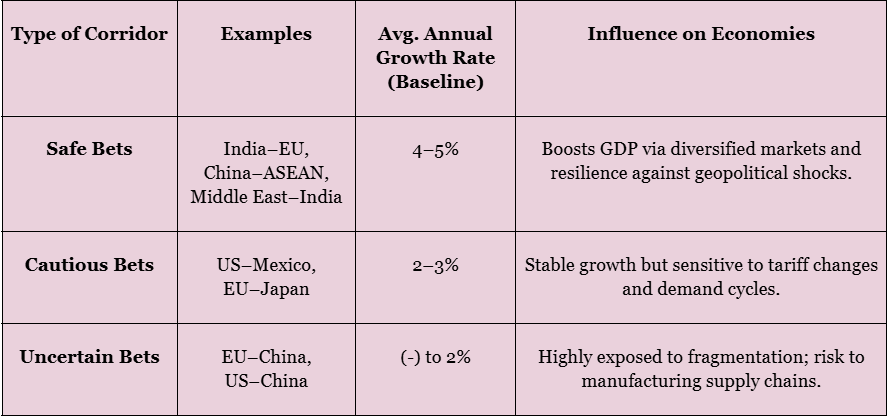Font size:
Print
Trade Corridors: Powerful Drivers of Global Economic Revival
Trade Corridors: The New Engines of Economic Growth
Context: By 2025, the balance of global economic power will have shifted towards the Global South, led by dynamic Asian and Gulf economies. With the Indo-Pacific now driving two-thirds of global growth and handling massive trade flows, outdated trade routes and infrastructure remain a bottleneck, prompting renewed focus on modern connectivity and maritime security.
What is the influence of global trade on different economies?
- Global trade shapes economic growth, industrial structure, and geopolitical influence. Trade corridors—structured pathways for goods, services, and resources—determine which economies gain more in the evolving order.
- Case Study: India–Middle East–Europe Economic Corridor (IMEC), announced at G20 (2023), is projected by the Economic Survey 2024-25 to reduce freight time by 40% between Mumbai and Europe, enhancing India’s export competitiveness.

Why are trade corridors significant?
- Engines of Economic Growth: Trade corridors integrate markets, reduce transportation costs, and facilitate scale economies. According to the Economic Survey 2024-25, a 10% reduction in logistics costs can raise India’s export competitiveness by up to 8%. Corridors like the International North–South Transport Corridor (INSTC) cut shipment time from Mumbai to Moscow by nearly 20 days.
- Strategic Autonomy & South-First Architecture: Plurilateral frameworks—Quad Ports of the Future, BRICS+, BIMSTEC—align investments in ports like Chabahar, Colombo, and Sittwe to reduce dependence on legacy chokepoints (Suez, Malacca). This supports Global South priorities in the Indo-Pacific, which accounts for 62% of global GDP (Raisina Dialogue 2025).
- Supply Chain Resilience: New corridors diversify maritime routes, integrate smart logistics, and support green shipping (e.g., India–Singapore Green & Digital Corridor), insulating trade from systemic shocks like the 2021 Suez blockage.
Why is it essential to avoid the weaponisation of trade corridors?
- Preventing Geoeconomic Coercion: Weaponisation—using trade routes to exert political pressure—can disrupt supply chains, as seen when the Strait of Hormuz tensions in 2019 caused oil prices to spike by 15% in a day (IEA data). In a fragmented order, over-reliance on a few chokepoints magnifies vulnerability.
- Ensuring Uninterrupted Global Commerce: With 80% of global trade seaborne (UNCTAD 2024), blockades or selective access denial can destabilise commodity markets, affecting inflation and food security. Avoiding weaponisation aligns with the WTO principle of “freedom of transit,” vital for least-developed and landlocked economies.
- Sustaining Multilateral Trust: Down To Earth (May 2025) notes that trade weaponisation undermines plurilateral trust, pushing nations into fragmented blocs. This risks a “race to the bottom” in tariffs and retaliatory measures, reducing potential global trade growth by $3 trillion by 2035 (McKinsey, 2025).
